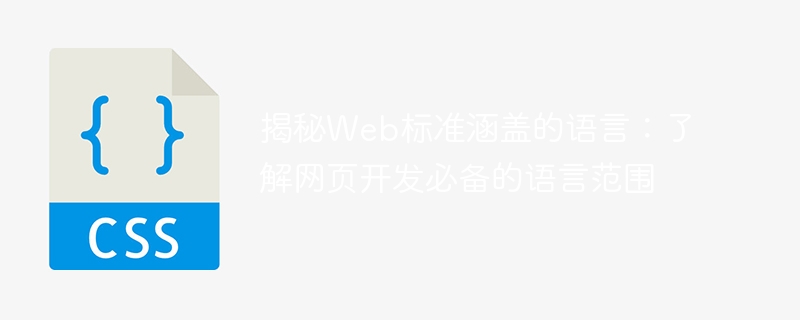

In today’s digital age, the Internet has become an indispensable part of people’s lives. As the basic unit of the Internet, web pages carry the important task of obtaining and sharing information. As a unique technology, web development is inseparable from some necessary languages. This article will reveal the languages covered by web standards, and let us understand the range of languages required for web development.
First of all, HTML (HyperText Markup Language) is the basis of web development. It is a standard markup language used to create the structure of web pages. HTML uses tags to define text, images, links and other elements and determine how they are displayed in the browser. Whether it's a simple paragraph or a complex table, HTML can help us build a variety of web pages.
Next, CSS (Cascading Style Sheets) is the language for controlling the style of web pages. HTML is responsible for the structure of a web page, while CSS is used to specify the appearance and layout of web page elements. Through CSS, we can define the color, font, background and other visual effects of the web page, so that the web page presents a consistent appearance and style. Compared with HTML, CSS is more flexible and powerful, and can achieve more complex page design effects.
In addition, JavaScript is a programming language used to implement web page interaction. HTML and CSS can only provide static content and styles for web pages, while JavaScript can add dynamic behavior to web pages. Through JavaScript, we can implement various interactive functions of web pages, such as form validation, animation effects, asynchronous data loading, etc. It is an integral part of modern web development.
In the language range covered by Web standards, there are some additional technologies and languages, such as XML (eXtensible Markup Language), used to transform and store data; AJAX (Asynchronous JavaScript and XML), used to implement Asynchronous data interaction; SVG (Scalable Vector Graphics), used to create vector graphics and more. The use of these languages and technologies has enriched the tools and functions of web development.
Although these languages and technologies have different characteristics and uses, there are close connections and mutual cooperation between them. HTML provides the basic structure of a web page, CSS controls the style of the web page, and JavaScript adds interactive behavior to the web page. The combination of these three can achieve rich and diverse web page effects and functions.
Because of this, understanding and familiarity with these languages is a basic requirement for web developers. Whether you are a beginner or an experienced developer, you need to master the basic concepts and usage of these languages. Fortunately, there are plenty of tutorials and resources on the Internet to learn from and reference to help us master these skills faster.
In addition, with the continuous development of the Internet, the field of web development is also constantly updated and improved. New languages and technologies are constantly emerging to meet the needs of more advanced and complex web pages. For example, the recently popular front-end frameworks such as React and Vue.js make web development more efficient and flexible.
In short, revealing the scope of languages covered by web standards, we can see that web development is inseparable from the three basic languages of HTML, CSS and JavaScript. Their application and cooperation create a rich and diverse web world for us. By mastering these languages, we can freely create personalized and interactive web pages, helping the Internet become a convenience and fun in our lives.
The above is the detailed content of Revealing the languages covered by web standards: Understand the range of languages necessary for web development. For more information, please follow other related articles on the PHP Chinese website!